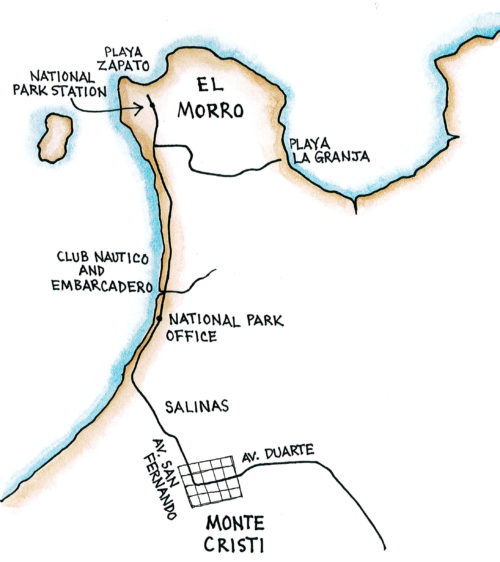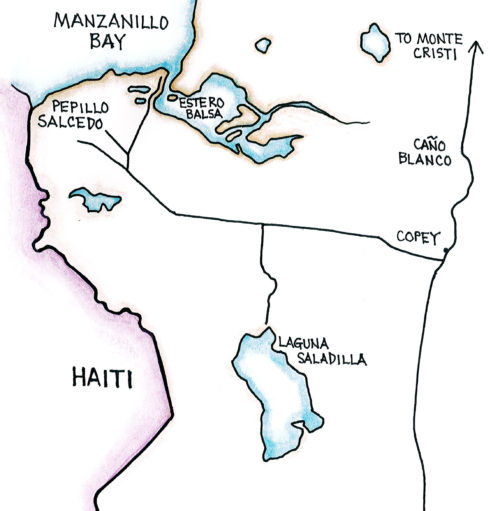Monte Cristi and Saladilla
The town of Monte Cristi is located in the northwest corner of the country and is best known for the massive El Morro headland, seen and named by Christopher Columbus (known in Spanish as Cristóbal Colón). The main birding attractions here are the extensive mangroves which can be explored by boat, and lagoons full of flamingos and other waterbirds hidden amongst cactus forests. Some of these sites are easily reached, while others require a guide. Besides flamingos, these wetland habitats host many herons, egrets, spoonbills, ibis, and other large waders, as well as shorebirds and waterfowl, including some hard-to-see species such as Ring-billed Gull and Gull-billed Tern. Although numbers of wintering ducks are reduced from historic highs, Monte Cristi is still one of the better places to find wintering and resident waterfowl.
South of Monte Cristi you will find other interesting birding areas, including Estero Balsa and Laguna Saladilla, most of which are protected as part of the large Montecristi National Park. Some of these sites are difficult to enter because of the thick vegetation around the shorelines. Beyond the wetland habitats the landscape is dominated by dry thorn scrub. The threatened Hispaniolan Parakeet is said to come down from the Cordillera Central to nest here, and other species typical of the lowlands should also be expected.

Site A: Salinas – The salt pans (salinas), and the dikes around the salt pans, attract a variety of smaller shorebirds. The dikes may be freely walked; look here for Black-necked Stilt, Willet, and a variety of migratory shorebirds. From near the salt ponds you can also look for herons, egrets and other wading birds coming in to roosts in the afternoon. Of particular note are the White Ibis and the Roseate Spoonbills.
Site B: Playa de la Granja – Drive or walk to Playa de la Granja. Follow Avenida San Fernando past the embarcadero and the Hostal San Fernando; look for an unmarked dirt trail just past the hostal. The road crosses the peninsula behind El Morro through low scrub forest to arrive at the mangrove, sea grape and scrub associated with this beach. Explore along the beach as well as the many small trails in the scrub. An interesting alternative to exploring this area on foot is to hire a boat and guide at the Club Nautico (just before the low bridge) or the embarcadero (just after the low bridge) on the way out to El Morro, and go through the mangroves on a small river.
The remaining sites are south of Monte Cristi along the Carretera Dajabón and are part of the Montecristi National Park. To reach these sites return through town on the Calle Duarte until you reach the prominent corner at Avenida Mella and turn south.

Site C: Marigó Wetlands – Leaving central Monte Cristi and heading south, in 2.7 km (1.7 miles) you will cross the Río Yaqui on an old bridge. Just 2.4 km (1.5 miles) further you will encounter the Marigó wetlands. Look for a narrow dirt or mud track on the right that is marked by a small cement block building. You may walk into the wetlands and salt flats.
Site D: La Mina – Continuing south on the Carretera Dajabón you will now be on a long, flat straightaway. Some 13 km (8.1 miles) from central Monte Cristi you will pass through the town of Nueva Judea. Less than 1.6 km (1 mile) beyond the town look for another narrow mud track on the right which is marked by a small concrete building. This is known as the “carretera La Mina” and can be walked as far as a small beach several kilometers distant.
Site E: Caño Blanco – As you continue south, Caño Blanco is a large lagoon that is reached 14.5 km (9 miles) from Monte Cristi. You may scan the lagoon from the road, or you may drive to the south end of the lagoon (about 0.8 or 0.5 miles further) to find a small access road that is marked by a concrete ruin. This road may be walked to the back side of Caño Blanco and beyond, including the area of the Laguna de Nelson which is known for its waterfowl numbers, but is also densely packed with red mangroves.
Site F: Laguna Saladilla – About 20.1 km (12.5 miles) south of Monte Cristi lies the town of Copey, and just beyond is the major crossroads of the Cruz de Manzanillo. Turning right (west) here will take you to the port town of Pepillo Salcedo (generally called Manzanillo), which lies on Manzanillo Bay. You will pass a military checkpoint; then, only 3.7 km (2.3 miles) from the crossroads, look on the left for a small lane just after an abandoned house. This lane will lead you to the margins of Laguna Saladilla. One of the local fishermen will gladly take you out on their boat to explore the lagoon for a small fee.
Site F: Estero Balsa – After traveling 6.4 km (4 miles) from the Cruz de Manzanillo on alternately paved and unpaved road through grazing lands and thorn scrub, on the outskirts of Manzanillo you will bear right at a prominent cemetery that lies on your right. Just beyond this fork is another signed fork; bear right again to reach the Estero Balsa. This leads to another nice wetlands ringed by mangroves. Backtracking to the last fork, you may take the left fork past the banana operations and down to the port where there is a small beach, another small wetland, and a cafeteria.
Target Species: West Indian Whistling- Duck, White- cheeked Pintail, Masked Duck, American Flamingo, Least Bittern, Little Blue Heron, Tricolored Heron, Reddish Egret, White Ibis, Roseate Spoonbill, Clapper Rail, Caribbean Coot, Black- bellied Plover, Snowy Plover, Semipalmated Plover, Northern Jacana, Great Black- backed Gull, Bank Swallow, Cave Swallow
Monte Cristi can be reached by taking Ave. John F. Kennedy in Santo Domingo to the Autopista Duarte and heading north. This is the main north-south highway in the country, and you will pass by Bonao, La Vega, and Santiago. After reaching Santiago, follow the highway signs to Monte Cristi on the Carretera Duarte (the extension of the Autopista Duarte). The drive should take about four and a half hours.
Once in Monte Cristi, you will be on Calle Duarte. This street will take you through the city center. But to reach the better hotels, restaurants and some nearby birding areas, you will want to continue straight ahead on Duarte, passing a prominent intersection with both Shell and Esso stations, and past a city park on your left with a prominent (and interesting) clock tower. Just after this park, and at a traffic light (which may or not be functioning), is Avenida San Fernando. Turn to the right here and head towards the coast. In less than 3 km you will cross through some salt pans, over a low bridge, and past a left hand turn to Playa Juan de Bolaños where a number of tourist accommodations are found. Straight ahead, and on the beach, is the prominent Hotel Montechico where the road turns eastward. Just past the hotel, and on the left is the national park office; on the right and just over a low bridge is the entrance to the embarcadero. Continuing another 2 km on this road will take you to Morro Beach.
